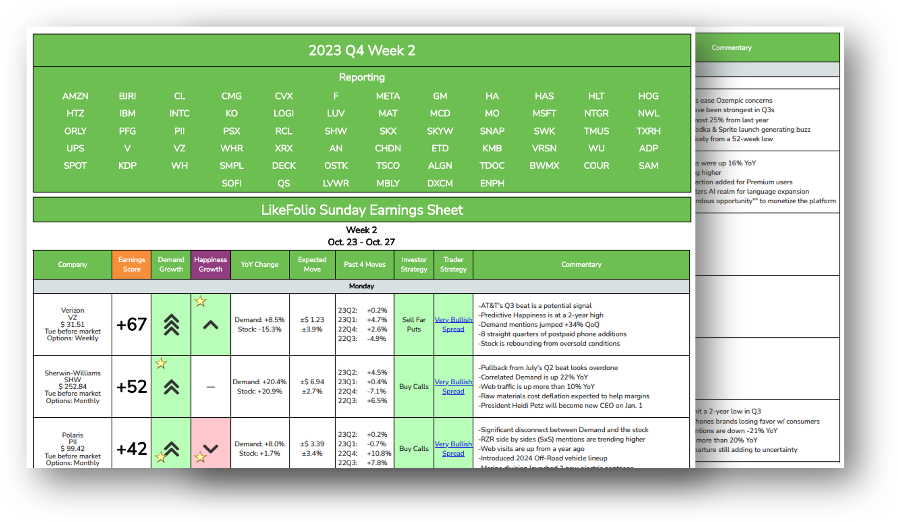The Investor's Guide to Earnings Season | Editor’s Note: On Tuesday, I introduced you to senior analysts Landon Swan and Andy Swan, the founders of LikeFolio and the brains behind Derby City Insights. Like me, fundamentals and advanced algorithms play key roles in their investment strategy. So, we decided to put our synergy to work for a special event: The A.I. Earnings Predictor Summit, which will be held next Tuesday, January 9, 2024, at 8 p.m. Eastern time. You can register for the event here.
Today, I wanted to share an article written by Andy, where he discusses the profits that can be unlocked during earnings season. You can check it out below… | | | Hello, Reader. Your first opportunity to make serious money in the stock market this year begins in just a couple of days.
With the start of earnings season.
It’s a cold, hard fact: stocks tend to make some of their biggest moves in the wake of quarterly earnings reports. Those initial moves can be positive or negative – and often feed into a prolonged rally or freefall.
On the bearish side of the coin, a company can report drops in sales or profits or, even worse, chop its outlook for “what comes next,” can send a stock into a quick decline.
And on the bullish side of the coin, there’s a “good/better/best” formula that’s easy to understand: - Good: a company beats forecasts on sales.
- Better: that company beats estimates on profits.
- Best: company leaders are so confident that they boost their forecast for sales and profits going forward
Want proof? Check out these recent examples: - Bearish: Tesla (TSLA) fell short of earnings and revenue expectations last quarter; after that disappointing report on October 18, shares closed the week 16% lower.
- Bullish: On November 29, Dollar Tree’s (DLTR) third-quarter results fell short of estimates – but with low expectations going in, and a “good enough” report, the stock ticked nearly 9% higher over the next two days.
- The Bullish “Trifecta": On November 9, Duolingo (DUOL) smoked third-quarter sales-and-profit estimates and raised its full-year guidance. After starting the week at $160.81, the stock zoomed 31% over the next four days, closing the week at an all-time high (and sustained that rally through the end of the year).
An Invitation to the "Earnings Season Party" These are not just a few “cherry-picked” examples. These assertions are backed by a lot of research.
For instance, a classic white paper by the National Bureau of Economic Research (NBER) found that that the days leading up to and following earnings announcements are characterized by above-average volume and wider price swings. 
This gives the shares of a soon-to-report company something called an "earnings announcement premium.”
In layman’s terms: When many investors show up to the party to trade on valuable new information, things can get crazy – if not downright out of hand.
Personally, I never show up to a party empty-handed – be it for the Kentucky Derby, the Super Bowl, or earnings season.
In our famous Weekly Earnings Scorecard, we boil down all of our consumer sentiment data, along with macro trends, to deliver our proprietary Earnings Score – a simple -100 to +100 metric that lets us know if we should be bullish, bearish, or neutral heading into the earnings event. 
Did we model this after a horse racing tip sheet inspired by a day at the track? Maybe. But you get the idea.
This is our high-level view of every company reporting earnings and the metrics that matter. View it as a “cheat sheet” for the company’s report. We then take it a step further by implementing bullish, bearish, or neutral options trading strategies.
We love using these strategies because they allow us to take on an appropriate, clearly defined (and limited) amount of risk – without having to go long or short on a stock.
The risk/reward calculus can be downright magical.
We're talking about a hefty payoff – with a very limited downside.
This is what earnings season is all about: Making informed decisions about whether a company will surprise to the upside or downside or simply meet expectations.
It's what makes these opportunities so potentially lucrative.
A key part of the earnings trading process is to learn from what went right and repeat what worked well.
For the stuff that didn’t work in your favor, we make adjustments and avoid making the same mistakes.
Stay tuned, |
.png)
.png)










ليست هناك تعليقات:
إرسال تعليق